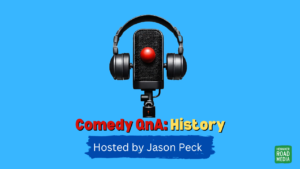There has been much written on the subject of verbal and non-verbal communication. I wanted to provide my 2 pence worth on this subject and how it relates to creating funny presentations. A vast majority of speakers and training companies often misuse research by Dr Albert Mehrabian who statistics have been massaged to provide us with quotes such as:
“Studies show that during interpersonal communication 7% of the message is verbally communicated. While 93% is non-verbally transmitted. Of the 93% non-verbal communication: 38% is through vocal tones, 55% is through facial expressions.”
This particular quote was taken from the website Select, Assess & Train. (Please note I am in no way disparaging this company I am only citing a source for the above quote).
However, as Professor Max Atkinson says in his book Lend Me Your Ears:
“if only 7% is verbally communicated there would be no need for anyone to learn foreign languages as we would already be able to understand 93% of them any one of them without any formal instruction at all”.
Fellow speaker and blogger Lisa Braithwaite has written on this subject before The truth about 7% – 38% – 55% and debunked a few myths as has Olivia Mitchell whose series of articles, including Why the stickiest idea in presenting is just plain wrong, about this very subject not only exposes some of the myths surrounding the blatant manipulation of these statistics, but also provides some alternative findings.
I remember when I first did a bit of my own research to discover more about Dr Mehrabian I saw that his findings did not relate to all forms of communication, or specifically public speaking at all. But I thought that seeing as there are many resources such as books, blogs and so on that reference these statistics, then I must be missing something.
He even says on his website about the research that appears in his book “Silent Messages” that:
“Please note that this and other equations regarding relative importance of verbal and nonverbal messages were derived from experiments dealing with communications of feelings and attitudes (i.e., like-dislike). Unless a communicator is talking about their feelings or attitudes, these equations are not applicable”.
Studies Show…
Upon reflection it turned out that all I was missing was talking about it on here as well as realising there was also a large problem of people not citing their sources. You’ll see in the above quote it says “studies show…” regular readers will know that this is one of my my pet peeves; which studies? Where’s your proof?
However, I do think that there is a danger in all of this. The danger being that new and established speakers alike don’t place the same emphasis on non-verbal communication as much as they did before and as a result they just become “talking heads” not using any movement at all.
Now, whilst the three aforementioned speakers have taken these findings apart piece by piece I do feel that there is a small element missing that needs to be addressed.
What’s that you ask?
Well, although the verbal and on-verbal communication statistics are inaccurate and are misused, what’s missing is the effect of the two different modes of communication when it comes to delivering humour.
Perhaps there needs to be new research conducted into this, but from experience at least, I know that when delivering humour (whether of the stand-up variety or a funny presentation) there is a proportion of non-verbal communication going on.
Yes, the majority of what occurs in these circumstances is verbally-driven, but what about those aspects of delivery that are non-verbal? I have gotten a laugh out of something I have done on stage as well as something I have said. There are also many other comedians and humorous speakers who have done the same.
Unfortunately, I have only experience to go on at the moment. No scientific studies to cite.
Little Humour Exercise
Not only that, but the other element of communication unaccounted for is the how. How is the verbal humour communicated? Try this:
– transcribe 2 minutes of your favourite comedian’s act, either from a DVD or from You Tube
– and then get a friend to read those words out loud.
Now, unless your have indicated who that comedian is or the reader is acutely aware of the material you have given them, so much of the humour will be lost as the original comedian’s attitude is not there.
Spoken humour is created for the ear and not just for the eye. Many, many times I have seen a comedian perform their act, which when quoted in the cold light of day by a critic is decidedly less funny. That’s the quickest way for someone to criticise a comedian’s act.
Funny on Page vs. Funny on Stage
A lot of humour teachers say that spoken word humour should read funny on the page. We should be able to see the joke that adheres to the three-line rule, or the one that conforms to the reverse doing its job on the page. But what about all those comedians and humorous speakers, past and present, who have no idea about that? They get on stage and just deliver the goods and if you were to read what they said, it wouldn’t be nearly as funny.
I agree that we shouldn’t hijack studies and research to manipulate for our own needs, as Braithwaite, Mitchell and Atkinson et al have been at pains to point out. We need to understand the statistics that we use and not “bend the rules”.
But I also think that some actual research needs to be conducted into the effect of personality and delivery to make speeches come alive. Words are very necessary, but we cannot rely on them at the detriment to delivery, especially when it comes to humour. There needs to be solid evidence and an explanation why both forms of communication are necessary.
Note: There are affiliate links on this page. That means that if you make a purchase via my link I get paid a commission. It helps me pay the bills.




3 comments
Great post, and thanks for linking to mine on Mehrabian! Now can we really get all these speakers to STOP misinterpreting the research? I hope so!
Author
Hey Lisa,
Thanks for that. I hope that we do, but it’s been quite ingrained in people’s consciousness for about 40-odd years so I doubt people will abandon it just yet.
I think it helps to somehow legitimise what it is that we do, and perhaps reduce people’s fear of forgetting their words as they mistakenly think that words are only 7% of our communication.
cheers
Ultimately what we are really talking about is the ability to do a good job at storytelling – for isn’t humor really a part of this skill?
No matter what the real stats are, if you can tell a funny story then you’ll have your entire audience hanging on your next word…
– Dr. Jim Anderson
The Accidental Communicator Blog
“Learn How To intimately connect with your audience in order to make an lasting impact in their lives.”
.-= Dr. Jim Anderson´s last blog ..Speaking Power: How To Get It, How To Use It =-.